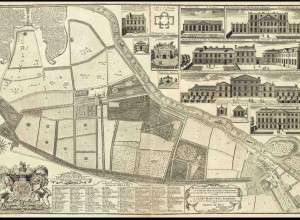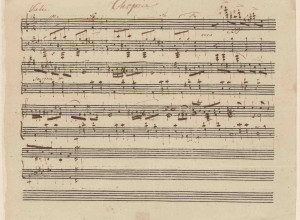New Imaging Technology Uncovers 400-Year-Old Hidden Elizabethan Text

A lightsheet used to reveal hidden text in one of the manuscripts of Camden's Annals
Through the use of new imaging technology, the British Library has been able to uncover hidden text in William Camden’s Annals, the first official account of Elizabeth’s reign, providing new perspectives on the Queen’s life.
Camden’s Annals, commissioned by King James I, has been described as the first history of Elizabethan England but the manuscript drafts in the national collection show how the text was extensively revised and self-censored. Uncovering previously hidden passages that have not been read for 400 years throws new light on famous episodes such as Elizabeth’s excommunication by Pope Pius V, the death of her arch-nemesis King Philip II of Spain, and Elizabeth’s nomination of James as her successor.
For centuries, dozens of passages in the original manuscript drafts of William Camden’s Annals have been invisible to the naked eye. In many instances, pieces of paper were pasted over the original text and the passages over-written, implying that Camden was concerned not to offend his patron, King James. Now, thanks to advances in enhanced imaging, these concealed lines can be read for the first time using transmitted light, offering a deeper insight into the political machinations of Elizabeth’s court.
Camden’s Annals is one of the most valuable sources on early modern Britain and is considered to be the official contemporary account of Elizabeth I’s reign (1558–1603). Written in Latin, the text is based on first-hand evidence such as eyewitness reports and official parliamentary records, collected by the historian William Camden (d. 1623). The Annals was started in Elizabeth’s lifetime but was completed in the first decades of the 1600s at the command of Elizabeth’s successor, King James I of England (James VI of Scotland).
Often regarded as the most important source in shaping the image of Elizabeth I and her reign, modern historians have commonly relied on Camden’s Annals as an impartial and supposedly accurate record. This new research reveals that key sections of the Annals were revised before publication, including Elizabeth I’s obituary, and the accounts of King James VI of Scotland and Elizabeth’s arch-rival King Philip II of Spain. It implies that Camden’s Annals were deliberately rewritten to present a version of Elizabeth’s reign that was more favourable to her successor.
Did James plot to assassinate Elizabeth?
In 1598, a man named Valentine Thomas confessed to having been sent by King James to murder Queen Elizabeth. Newly studied passages reveal that Camden initially intended to keep this shocking information in the Annals, but he subsequently amended and softened the confession to say that Thomas ‘had accused the King of Scots with ill affection towards the Queen’. James had never plotted against Elizabeth, but he was highly sensitive to any slander against him, having sent other writers to prison for offending him.
How did Philip II die?
The section of the Annals that covers the death of Elizabeth’s arch-rival King Philip II in 1598 was also amended. The original text, which hasn’t been seen for 400 years, reports that Philip ‘had no imperial skills’. The original drafts also reveal that he had died of “phthiriasis”, a gruesome disease by which parasites multiply in the human body, which was seen as a divine punishment from God. These phrases were removed so as not stain Philip’s legacy and to protect Camden from any allegations of bias in his history.
Accusing Rome of plotting against Elizabeth I
In 1570, Elizabeth was excommunicated by Pope Pius V. It appears that Camden intended to paraphrase this episode, before he changed his mind and decided instead to include the whole document of excommunication, effectively removing his own commentary on why this had happened. His original paraphrase attributes the Pope’s motives to ‘spiritual warfare’, which was covered over and replaced in the published version with the statement that Pius was creating ‘secret plots’ against Elizabeth. By removing the previously inflammatory wording, Camden made the official record more neutral in tone.
Did Elizabeth I name James as her successor?
Camden’s Annals ends with Elizabeth I’s obituary, in which she is said to have named James VI of Scotland as her successor on her deathbed. Elizabeth never married and she died childless in 1603, to be succeeded on the English throne by Mary’s son, James VI of Scotland. Analysis of the manuscript drafts shows that the deathbed scene was a fabricated addition that Camden did not intend originally to put into his history. He presumably included it to appease James, so that his succession looked more predetermined than it had actually been. Elizabeth was too ill to speak in her final hours and no other historical evidence points to this deathbed scene being true.
The manuscript
The handwritten manuscript drafts are still being analysed in detail, with the previously hidden sections being revealed for the first time and translated from Latin into English. This research has been undertaken by DPhil student Helena Rutkowska, as part of a Collaborative Doctoral Award at the University of Oxford in partnership with the British Library and Open University, and it represents a significant finding in early modern historical scholarship.
Helena Rutkowska said: "William Camden’s Annals has long been regarded the first history of Elizabeth’s reign and it’s been a thrill to have the chance to use new imaging technology thanks to my collaborative PhD with the British Library to explore hundreds of previously covered passages in Camden’s text for the first time. While historians have studied the Annals in print before, an in-depth analysis of the manuscript drafts has never been done and the sheer amount of new information we have been able to discover regarding Elizabeth’s reign has been astounding."















